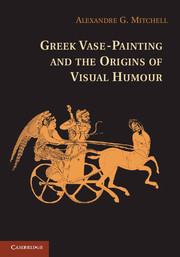Book contents
- Frontmatter
- Epigraph
- Contents
- List of Illustrations
- List of Tables
- Preface
- Acknowledgements
- Abbreviations
- GREEK VASE-PAINTING AND THEORIGINS OF VISUAL HUMOUR
- One Introduction
- Two Humour in the City
- Three Humour in the City
- Four Satyrs and Comic Parody
- Five Caricatures inAthens and at the Kabirion Sanctuary in Boeotia
- Six Conclusion
- Glossary
- Bibliography
- Index of Vases Cited in the Text
- General Index
One - Introduction
Published online by Cambridge University Press: 05 January 2014
- Frontmatter
- Epigraph
- Contents
- List of Illustrations
- List of Tables
- Preface
- Acknowledgements
- Abbreviations
- GREEK VASE-PAINTING AND THEORIGINS OF VISUAL HUMOUR
- One Introduction
- Two Humour in the City
- Three Humour in the City
- Four Satyrs and Comic Parody
- Five Caricatures inAthens and at the Kabirion Sanctuary in Boeotia
- Six Conclusion
- Glossary
- Bibliography
- Index of Vases Cited in the Text
- General Index
Summary
We rushed onto him with a shout, and threw our arms around him; but the old man had not forgotten his crafty ways. No, at first he turned into a bearded lion, and then into a snake, and a leopard, and a huge boar; then he turned into flowing water, and into a tree, high and leafy; but we held on unflinchingly with a resolute heart. But, when at last that old man, skilled in pernicious arts, grew weary, then he questioned me and spoke.
Humour, just like Proteus, can take on many shapes, jumping erratically from one form into another, from parody into caricature, from puns into situation comedy. But if one struggles with it long enough, it will in the end, as Proteus did, deliver some truths and sometimes even insights into the human psyche. Most anthropologists and historians know that a writer, or indeed anyone who chooses to mock something or someone, reveals more about himself than about the object of his mockery. The visual jokes tell us something about rules of behaviour, about the differences between the public and the private sphere, about gender differences, ethnicity, politics, beauty and deformity, buying patterns, fashion, perceptions of religion and myth. It often tells us what people really thought and experienced. This book fits in the framework of the ‘rediscovered’ cultural historical trend in archaeology. Current theory is in its post-processual stage, where for many archaeologists, like Ian Morris, ‘Archaeology is cultural history or it is nothing’. Classical archaeologists have often been at odds with the radical theoretical changes in archaeology because of the vast amount of literary and epigraphic evidence available to us, and utterly absent from other forms of archaeology, which have had to formulate new theoretical models to tackle their lack of other forms of evidence than archaeological. Numerous scholars have discussed these prickly issues, and some, such as Shanks, have even tried in recent years to put together a ‘social archaeology’ adapted from its prehistoric model to classical archaeology. It is an exciting stage in theoretical archaeology, and I for one am glad that we are back in the world of cultural history with a better anthropological grip on who we are to better understand what we observe.
- Type
- Chapter
- Information
- Greek Vase-Painting and the Origins of Visual Humour , pp. 1 - 35Publisher: Cambridge University PressPrint publication year: 2009



